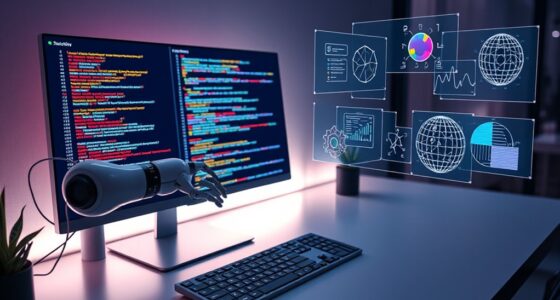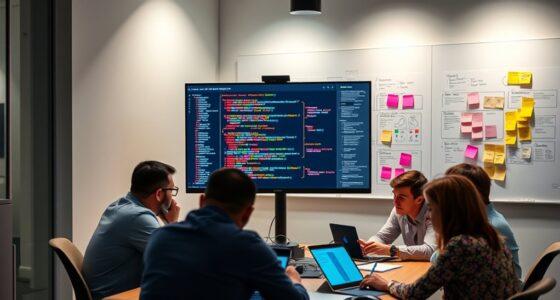Building AI agents using multi-agent systems helps you create software where multiple intelligent entities work together to solve complex tasks. These systems focus on autonomy, cooperation, and adaptability, allowing agents to perceive their environment, communicate, and coordinate actions effectively. You can leverage distributed intelligence to improve fault tolerance, scalability, and efficiency across diverse applications like autonomous vehicles or smart grids. Keep exploring to discover how these systems can transform your AI solutions into more resilient and adaptable ones.
Key Takeaways
- Multi-agent systems enable multiple AI agents to collaboratively achieve complex goals through coordination and communication.
- Designing effective protocols and negotiation strategies ensures seamless interaction among agents.
- Distributed intelligence enhances fault tolerance, scalability, and system resilience in multi-agent architectures.
- Balancing autonomy and cooperation allows agents to process local information while contributing to global objectives.
- Practical applications include autonomous vehicles, smart grids, and distributed decision-making systems.

Multi-agent systems are transforming the way we develop intelligent software by enabling multiple AI agents to work together toward common goals. This collaboration hinges on effective agent coordination, which guarantees each agent contributes efficiently without conflicts or redundancies. When you design a multi-agent system, you’re fundamentally creating a network where each agent acts semi-independently, yet harmoniously, to achieve a shared objective. This setup leverages distributed intelligence, meaning the decision-making process isn’t centralized but spread across the agents. Instead of relying on a single, monolithic system, you distribute tasks among several agents, each equipped with its own capabilities and knowledge base. This approach allows the system to be more flexible, scalable, and resilient.
In practice, agent coordination involves establishing protocols, communication methods, and rules that govern how agents interact. You might implement negotiation strategies, voting mechanisms, or shared data repositories to facilitate seamless cooperation. For instance, in a multi-robot system, each robot—or agent—must communicate its status, share information, and negotiate tasks to avoid collisions or overlaps. This coordination is critical because it guarantees that agents don’t work at cross-purposes or waste resources. By designing clear communication channels and protocols, you enable agents to adapt dynamically to changing environments and tasks, maintaining efficiency and robustness.
Distributed intelligence in multi-agent systems offers significant advantages. Because decision-making is decentralized, the system can operate even if some agents fail, enhancing fault tolerance. Plus, distributing tasks allows for parallel processing, which accelerates problem-solving, especially in complex scenarios. As you build these systems, you focus on how each agent perceives its environment, processes information, and acts accordingly. The agents must be capable of local reasoning but also aware of the broader system’s goals, which requires a well-structured architecture that supports both autonomy and cooperation.
Ultimately, successful multi-agent systems depend on your ability to manage agent coordination and harness distributed intelligence effectively. When you create such systems, you’re building a network of intelligent components that work together more efficiently than any single agent could alone. This synergy enables applications across various fields—from autonomous vehicles to smart grids—making your AI solutions more adaptable, scalable, and resilient.
Frequently Asked Questions
How Do Multi-Agent Systems Handle Conflicting Goals Among Agents?
You handle conflicting goals among agents through conflict resolution and goal negotiation. You facilitate communication where agents express their objectives, then use negotiation strategies to find common ground or compromise. By establishing protocols for resolving disputes and prioritizing goals, you guarantee the system functions smoothly. This way, agents work collaboratively, balancing individual aims with overall system efficiency, leading to effective multi-agent interactions.
What Are the Best Practices for Designing Scalable Multi-Agent Architectures?
To design scalable multi-agent architectures, you should focus on fostering effective agent communication and guaranteeing system modularity. Use clear communication protocols to enable seamless interaction among agents, which helps manage complexity as the system grows. Keep your system modular by dividing it into independent components, allowing you to add or modify agents without disrupting the whole. This approach ensures scalability, flexibility, and easier maintenance in your multi-agent system.
How Is Security Managed in Multi-Agent Systems?
Imagine agents as vigilant guards patrolling a network, constantly scanning for threats. You manage security by implementing robust agent authentication to verify identities and prevent unauthorized access. Threat detection systems help you identify suspicious activities early, allowing quick responses. Regular updates, encryption, and secure communication protocols further protect your multi-agent system. By staying proactive, you keep your system resilient against cyber threats and ensure data integrity.
Can Multi-Agent Systems Learn and Adapt Over Time?
Yes, multi-agent systems can learn and adapt over time. You leverage learning adaptability by enabling agents to analyze their environment and update their strategies accordingly. As they interact, they develop evolving strategies that improve performance and cooperation. This continuous process allows the system to respond to changing conditions, making it more robust and flexible. Your agents become smarter, refining their actions for better outcomes through ongoing learning and adaptation.
What Industries Are Currently Leading in Multi-Agent System Adoption?
Think of industries racing like a high-speed train—healthcare innovation and autonomous vehicles lead the charge. You’ll find healthcare uses multi-agent systems to coordinate patient care and optimize diagnostics. Meanwhile, autonomous vehicles rely on them for real-time decision-making and navigation. These sectors harness multi-agent technology to boost efficiency, safety, and adaptability, making them pioneers in adopting multi-agent systems and shaping the future of smart, connected solutions.
Conclusion
As you explore multi-agent systems, you might find it’s no coincidence that these intelligent agents often mirror real-world collaboration. By understanding their dynamics, you’re better equipped to build smarter, more adaptable software. The more you delve into their complexities, the more you realize how seamlessly they can solve problems together—almost like a coincidence of design and purpose. Keep experimenting, and you’ll discover how these agents can transform your software solutions in unexpected ways.









